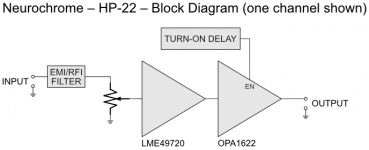It turns out that high-end DIY actually can be affordable. Who knew?!  Build your Neurochrome HP-22 headphone amp for less than $100!
Build your Neurochrome HP-22 headphone amp for less than $100!
I have just opened up for preorders of the HP-22 circuit board and will offer a preorder discount until the boards arrive in stock. I expect to start shipping them by December 22, 2020. If you use FedEx or UPS for the shipping method, you'll be ready to build just after Christmas. You can preorder your HP-22 circuit board here: HP-22 – Neurochrome
The HP-22 mounts as a shield atop a Texas Instruments OPA1622 evaluation module (EVM) to form a complete high-performance headphone amp. The amp provides 200 mW into 300 Ω, 360 mW into 50 Ω, and 200 mW into 32 Ω at -130 dB (0.00003% THD). The multi-tone IMD residual measures below -146 dBr (referenced to 100 mW into 300 Ω).
Tweakers will be delighted to know that the HP-22 lends itself to opamp experimentation. Should you prefer to use a different opamp than the specified LME49720, have at it! Just make sure to select one that's stable at +10 dB gain and capable of driving a 1 kΩ load impedance cleanly.
Speaking of gain... The gain of the HP-22 is +10 dB. Should you wish for a higher or lower gain, all you need to do is to change a resistor.
The OPA1622 EVM comes with rubber feet, so the HP-22 will sit neatly on a tabletop even without a chassis. As it contains the input RCA connectors, the volume control, and the output connector the HP-22 can be used without a chassis if desired. It can even be powered by a pair of 9 V batteries. And, naturally, if you wish to mount the HP-22 in a chassis, you can easily mount it to the front panel using the volume pot mounting hardware and connect the RCA connectors with wires.
The images below show my prototype build. The hockey puck was included in the picture as a scale indicator. The HP-22 is rather tiny. Maybe if I was a better marketeer, I would claim that the proprietary Neurochrome puck is made from a unique and patented rubber compound, which provides vibration control and resonance dampening.
You can find all the performance graphs and specs on the HP-22 product page: HP-22 – Neurochrome
All measurements were performed with the HP-22 powered by a Neurochrome Preamp Power Supply.
Tom
I have just opened up for preorders of the HP-22 circuit board and will offer a preorder discount until the boards arrive in stock. I expect to start shipping them by December 22, 2020. If you use FedEx or UPS for the shipping method, you'll be ready to build just after Christmas. You can preorder your HP-22 circuit board here: HP-22 – Neurochrome
The HP-22 mounts as a shield atop a Texas Instruments OPA1622 evaluation module (EVM) to form a complete high-performance headphone amp. The amp provides 200 mW into 300 Ω, 360 mW into 50 Ω, and 200 mW into 32 Ω at -130 dB (0.00003% THD). The multi-tone IMD residual measures below -146 dBr (referenced to 100 mW into 300 Ω).
Tweakers will be delighted to know that the HP-22 lends itself to opamp experimentation. Should you prefer to use a different opamp than the specified LME49720, have at it! Just make sure to select one that's stable at +10 dB gain and capable of driving a 1 kΩ load impedance cleanly.
Speaking of gain... The gain of the HP-22 is +10 dB. Should you wish for a higher or lower gain, all you need to do is to change a resistor.
The OPA1622 EVM comes with rubber feet, so the HP-22 will sit neatly on a tabletop even without a chassis. As it contains the input RCA connectors, the volume control, and the output connector the HP-22 can be used without a chassis if desired. It can even be powered by a pair of 9 V batteries. And, naturally, if you wish to mount the HP-22 in a chassis, you can easily mount it to the front panel using the volume pot mounting hardware and connect the RCA connectors with wires.
The images below show my prototype build. The hockey puck was included in the picture as a scale indicator. The HP-22 is rather tiny. Maybe if I was a better marketeer, I would claim that the proprietary Neurochrome puck is made from a unique and patented rubber compound, which provides vibration control and resonance dampening.
You can find all the performance graphs and specs on the HP-22 product page: HP-22 – Neurochrome
All measurements were performed with the HP-22 powered by a Neurochrome Preamp Power Supply.
Tom
Attachments
-
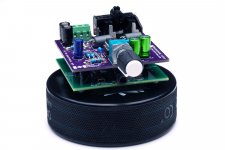 HP-22_Proto_wPuck.jpg193.1 KB · Views: 1,136
HP-22_Proto_wPuck.jpg193.1 KB · Views: 1,136 -
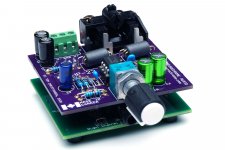 HP-22_Proto_Front.jpg197 KB · Views: 1,135
HP-22_Proto_Front.jpg197 KB · Views: 1,135 -
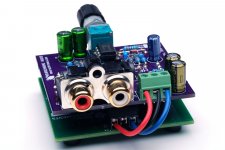 HP-22_Proto_Rear.jpg183.9 KB · Views: 1,135
HP-22_Proto_Rear.jpg183.9 KB · Views: 1,135 -
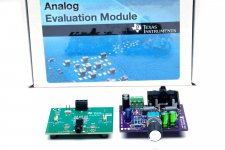 HP-22_Proto_wTIbox.jpg199.2 KB · Views: 1,121
HP-22_Proto_wTIbox.jpg199.2 KB · Views: 1,121 -
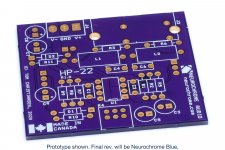 HP-22_Proto_PCB.jpg253.7 KB · Views: 1,095
HP-22_Proto_PCB.jpg253.7 KB · Views: 1,095 -
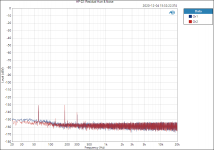 HP-22_ Residual Hum & Noise.png48.8 KB · Views: 359
HP-22_ Residual Hum & Noise.png48.8 KB · Views: 359 -
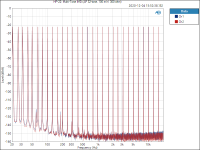 HP-22_ Multi-Tone IMD (AP 32-tone, 100 mW, 300 ohm).png71 KB · Views: 331
HP-22_ Multi-Tone IMD (AP 32-tone, 100 mW, 300 ohm).png71 KB · Views: 331 -
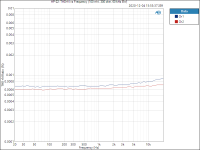 HP-22_ THD+N vs Frequency (100 mW, 300 ohm, 60 kHz BW).png26.1 KB · Views: 318
HP-22_ THD+N vs Frequency (100 mW, 300 ohm, 60 kHz BW).png26.1 KB · Views: 318 -
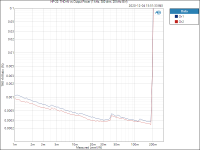 HP-22_ THD+N vs Output Power (1 kHz, 300 ohm, 20 kHz BW).png33.4 KB · Views: 522
HP-22_ THD+N vs Output Power (1 kHz, 300 ohm, 20 kHz BW).png33.4 KB · Views: 522
A couple (+?) of questions:
1) What is the maximum gain without much loss in the superb specs? it looks like a natural to drive the Mofo source follower amp used as a preamp providing all the gain. Goal would be around 50VAC peak to peak into 20K ohms.
2) what is the input impedance?
3) I also notice that TI limits the sale of evalutation modules to 1 per customer. Can you usually place separate orders some days apart to buy several?
Looks intriguing!, TIA
Skip
1) What is the maximum gain without much loss in the superb specs? it looks like a natural to drive the Mofo source follower amp used as a preamp providing all the gain. Goal would be around 50VAC peak to peak into 20K ohms.
2) what is the input impedance?
3) I also notice that TI limits the sale of evalutation modules to 1 per customer. Can you usually place separate orders some days apart to buy several?
Looks intriguing!, TIA
Skip
I would expect a slight but measurable degradation in THD once the gain gets beyond 20 dB. That said, you could probably run it at 60 dB gain before the THD became audible. The noise would be horrendous at 60 dB gain, but the THD wouldn't. 
50 V peak-to-peak won't happen on a ±17 V power supply, though. Can you live with 34 Vpp?.
The input impedance is 10 kΩ.
I'm not aware of the TI limitations. I bought one OPA1622EVM a few years back when the idea of this headphone first entered my mind and another one recently to make sure TI hadn't changed the locations of the connectors. I had no issue buying them.
I tried just now to order an OPA1622EVM. The TI cart does say "limit: 1", but I have no issue starting the checkout process. So I think if you place the orders a few days apart, you're probably OK. If not, just order through Mouser.
Tom
50 V peak-to-peak won't happen on a ±17 V power supply, though. Can you live with 34 Vpp?.
The input impedance is 10 kΩ.
I'm not aware of the TI limitations. I bought one OPA1622EVM a few years back when the idea of this headphone first entered my mind and another one recently to make sure TI hadn't changed the locations of the connectors. I had no issue buying them.
I tried just now to order an OPA1622EVM. The TI cart does say "limit: 1", but I have no issue starting the checkout process. So I think if you place the orders a few days apart, you're probably OK. If not, just order through Mouser.
Tom
Here's the block diagram of the HP-22. It's pretty straight-forward. The main snag in the design is that the OPA1622EVM has a rather low input impedance (1 kΩ). I also pulled some tricks to get the amp start up without creating a large pop.
Tom
Tom
Attachments
I tried just now to order an OPA1622EVM. The TI cart does say "limit: 1", but I have no issue starting the checkout process. So I think if you place the orders a few days apart, you're probably OK. If not, just order through Mouser.
Tom
I can ask the product line to look into this and see if they can up the limit.
Goal would be around 50VAC peak to peak into 20K ohms.
Ya know... With 20 kΩ load, you could run the two channels bridged. That would give you up to 68 Vpp. It would unfortunately also require the 20 kΩ impedance to be floating (or at least differential).
Tom
The quote for the PCB manufacturing is in. I was able to drop the price by $10.
Note that the PCBs will be made in Canada. They're gold plated and fully electrically tested by the manufacturer. Buy yours here: HP-22 – Neurochrome
Tom
Note that the PCBs will be made in Canada. They're gold plated and fully electrically tested by the manufacturer. Buy yours here: HP-22 – Neurochrome
Tom
I can ask the product line to look into this and see if they can up the limit.
Update: I contacted the online store folks to up the max qty on these EVMs. It's a work in progress. I will post here when it's complete.
Ya know... With 20 kΩ load, you could run the two channels bridged. That would give you up to 68 Vpp. It would unfortunately also require the 20 kΩ impedance to be floating (or at least differential).
As an alternative, I have a pair of Magnequest EXO 173 autoformers designed for use as phase splitters but would provide a 2:1 voltage lift wired correctly. The downside with them is that they are totally intolerant of DC, so I would need to have a cap before and after the autoformer.
It would be interesting to see which alternative would sound best. Input impedance to the bridged units would be halved.
Skip
How much current does this draw?
15 mA, typical. 20.4 mA, worst case. Plus the load current, which will depend on how loud you crank the tunes and the impedance of your headphones.
A power supply that can provide at least 200 mA at ±12 V is about optimal.
Tom
As an alternative, I have a pair of Magnequest EXO 173 autoformers designed for use as phase splitters but would provide a 2:1 voltage lift wired correctly. The downside with them is that they are totally intolerant of DC, so I would need to have a cap before and after the autoformer.
I highly doubt the transformer would mind the few hundred microvolt of DC of the HP-22. The DCR of the transformer is probably in the kΩ, so you're looking at nA of DC current. That shouldn't bother anybody.
Update: I contacted the online store folks to up the max qty on these EVMs. It's a work in progress. I will post here when it's complete.
Awesome. Thanks, John.
Tom
I highly doubt the transformer would mind the few hundred microvolt of DC of the HP-22. The DCR of the transformer is probably in the kΩ, so you're looking at nA of DC current. That shouldn't bother anybody.
Easy to try both ways. I think I'll go for a couple. Do you email the BOM on purchase when it's a pre-order?
Skip
I'll start writing the documentation for the HP-22 tomorrow and wrap it up the day the boards get in (I need pictures with the final boards). Once I stuff the envelope with your boards, I'll send out an email with a download link to the documentation. Given that Canada Post and USPS take about three weeks to deliver these days that should give you quite a while to get the parts ordered.
I expect the first orders to ship on December 22.
Thank you for your preorder and thanks in advance for your patience.
Thanks,
Tom
I expect the first orders to ship on December 22.
Thank you for your preorder and thanks in advance for your patience.
Thanks,
Tom
Is there any alternative to your recommended power supply or 9v battery, like a wall plug (uk type)power supply. I don't really trust myself with 220v. My Cheap skate mind also feel like the cost of the power supply defies the purpose of a budget friendly headphone amp. Especially, when I need to source an enclosure.
Otherwise, this is a great Christmas present, thank you Tom. I think I am going to buy it to replace of O2 amp.
Otherwise, this is a great Christmas present, thank you Tom. I think I am going to buy it to replace of O2 amp.
I was thinking of using the Silent Switcher (Linear Audio Silent Switcher V3 – diyAudio Store) because I already have one, but it can only deliver 170mA @ +/-12v which may not be enough.
I was thinking of using the Silent Switcher (Linear Audio Silent Switcher V3 – diyAudio Store) because I already have one, but it can only deliver 170mA @ +/-12v which may not be enough.
Yeah. 170 mA is technically a bit low, but in practice you'll probably be fine. Basically with the lower supply current you would run out of current when driving headphones lower than about 100 Ω to clipping levels. But that would probably be unbearably loud anyway. If you already have a SilentSwitcher, I don't see any reason why you wouldn't use it. At least give it a whirl and let us know.
This looks small enough that I could probably put it in my DAC. The DAC has volume control so I wouldn't need the pot. So how would the wiring change?
If you don't want/need the volume control, you can just bridge two terminals on the volume pot footprint. I should add that information to the design doc.
Tom
Last edited:
- Home
- Vendor's Bazaar
- Neurochrome HP-22: A high-performance DIY headphone amp for less than $100
